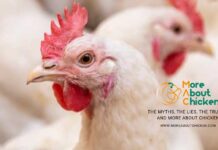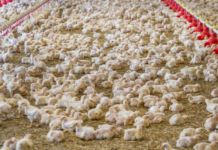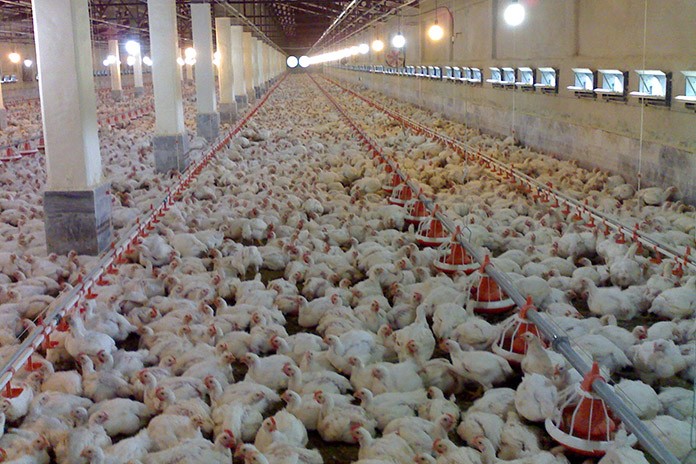
Although corn prices have dropped from historic highs in the past years, energy continues to be one of the driving costs in poultry feeding. The use of corn to produce ethanol and field oils to produce biodiesel for fuel has linked food production to the crude oil markets and will continue to play a role in corn prices.
This link has increased price volatility including price spikes in 2009 and continued higher prices for the energy component of the diet. The general cost of energy has resulted in a market for feed additives that either liberate more energy from poultry diets (generally carbohydrate enzymes) or modify bird responses to partition energy resources away from maintenance and towards productive purposes (historically growth promoting antibiotics). The continued focus on energy in feeds resulted in the need to accurately and quickly evaluate the differences in dietary energy in chickens.
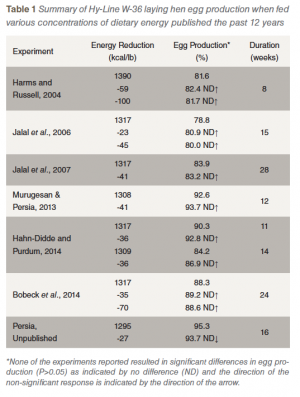 Summation of the peer reviewed publication record (12 year period) using Hy-Line W-36 laying hens fed various concentrations of dietary energy is reported in Table 1.
Summation of the peer reviewed publication record (12 year period) using Hy-Line W-36 laying hens fed various concentrations of dietary energy is reported in Table 1.
The W-36 hen is a light framed bird with high feed efficiency due to robust egg production with limited feed intake. Review of the table indicates that decreases in dietary energy of up to 100 kcal/lb for eight weeks or 70 kcal/lb for 24 weeks had no significant effect on egg production or feed efficiency. There were generally small increases in feed intake (when not controlled) associated with the decreased dietary energy, but sensitivity of the majority of the experiments precluded significant effects of dietary energy on feed intake. These small increases in feed intake might not be considered a large effect, but when calculating AME intake this 1 g difference can compensate for differences in dietary energy.
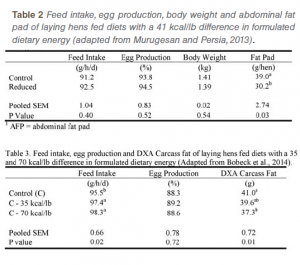 A second factor to consider is the fate of dietary energy in poultry. There are three primary mechanisms that chickens use for dietary energy; maintenance, production (either lean tissue production or egg production) and storage as fat. Table 2 shows the that laying hens fed diets with a 41 kcal/lb reduction in dietary energy for 12 weeks resulted in similar egg production and body weight, but significantly reduced abdominal fat pad in response to the reduced dietary energy. This response highlights the ability of the hen to continue egg production unabated by drawing down body fat reserves to compensate for reduced dietary energy, at least in the short term. A longer term, 24 week, experiment was conducted to determine the effects of 35 and 70 kcal/lb differences in dietary energy on egg production and carcass fat as determined by Duel-energy X-ray Absorptiometry (DXA) scan. In Table 3, feed intake was significantly increased by energy reduction but the differences were still relatively small, 2 and 3 g, despite the 70 kcal/lb reduction in dietary energy. Even considering the increased feed intake, DXA scan for fat mass indicated that the reduced dietary energy resulted in reduction in body fat before egg production was negatively affected. Both experiments indicate that laying hens sacrifice body fat storage before reducing egg production as it appears that body composition is a more sensitive indicator of short term dietary energy content than egg production. An explanation for comes from the observation that reduced body fat (below average body condition score) is natively associated with effective reproduction. Current poultry data to support this statement is hard to find as most of the work in this area has been around reducing feed intake in broiler breeder diets to increase reproductive performance, but limited data are available using a starvation model with Adelie penguins as birds with increased body intake in broiler breeder diets to increase reproductive performance, but limited data are available using a starvation model with Adelie penguins as birds with increased body condition resulted in more successful breeding than birds with lower body condition.
A second factor to consider is the fate of dietary energy in poultry. There are three primary mechanisms that chickens use for dietary energy; maintenance, production (either lean tissue production or egg production) and storage as fat. Table 2 shows the that laying hens fed diets with a 41 kcal/lb reduction in dietary energy for 12 weeks resulted in similar egg production and body weight, but significantly reduced abdominal fat pad in response to the reduced dietary energy. This response highlights the ability of the hen to continue egg production unabated by drawing down body fat reserves to compensate for reduced dietary energy, at least in the short term. A longer term, 24 week, experiment was conducted to determine the effects of 35 and 70 kcal/lb differences in dietary energy on egg production and carcass fat as determined by Duel-energy X-ray Absorptiometry (DXA) scan. In Table 3, feed intake was significantly increased by energy reduction but the differences were still relatively small, 2 and 3 g, despite the 70 kcal/lb reduction in dietary energy. Even considering the increased feed intake, DXA scan for fat mass indicated that the reduced dietary energy resulted in reduction in body fat before egg production was negatively affected. Both experiments indicate that laying hens sacrifice body fat storage before reducing egg production as it appears that body composition is a more sensitive indicator of short term dietary energy content than egg production. An explanation for comes from the observation that reduced body fat (below average body condition score) is natively associated with effective reproduction. Current poultry data to support this statement is hard to find as most of the work in this area has been around reducing feed intake in broiler breeder diets to increase reproductive performance, but limited data are available using a starvation model with Adelie penguins as birds with increased body intake in broiler breeder diets to increase reproductive performance, but limited data are available using a starvation model with Adelie penguins as birds with increased body condition resulted in more successful breeding than birds with lower body condition.
In conclusion, recent data published concerning the effects of dietary energy on laying hen egg production have not resulted in any significant differences for the small-framed W-36 laying hen, at least within 28 wk of egg production. These results are not completely surprising as small differences in feed intake may alter daily energy intake, blunting the ability to recognize small difference in dietary energy. In addition to feed intake, body composition appears to be more sensitive than egg production when considering small to moderate changes in dietary energy over a short time period. This validation of body composition as a sensitive indicator of dietary energy status can be utilized to effectively evaluate feed additives in laying hen diets.
Considerable research has been conducted concerning the effects of dietary energy on feed intake and feed efficiency in broiler chickens. General responses to dietary energy are more consistent with increased feed intake and altered feed conversion in older production ages (above 42 days of age) when broilers have a larger capacity to increase feed intake in comparison to younger birds. At commercial energy concentrations, differences in dietary energy above 45 kcal/lb generally result in consistent increases in feed intake and a subsequent worsening of feed conversion, but these results become much less reliable under 45 kcal/lb.
Calcium has long been recognized for its ability to reduce the utilization of dietary fat in poultry diets. As so an experiment was conducted to understand the effects of high dietary Ca on corn and soy oil energy digestibility in 28 day old broiler chickens. Exact differences in dietary energy due to high calcium supplementation have not been quantified yet, but performance results indicated that body weights were similar between the normal and high calcium diets, but feed efficiency tended to be worsened in the high calcium diets (P≤ .10). At the end of the experimental period all remaining birds were euthanized and scanned using Dual-energy X-ray Absorptiometry. As expected, lean tissue mass was not affected by the high calcium diet, but fatty tissue mass and percentage of total mass were both reduced when the high calcium diet was fed (P≤0.05). The increased sensitivity of the DXA scan in comparison to the feed efficiency may provide some evidence that fat storage is a better indicator of energy status in broiler chickens, especially when lower dietary energy differences are concerned and in younger broiler chickens with limited ability to increase feed intake in response to lower dietary energy.
References are available on request
From the proceedings of Midwest Poultry Federation



